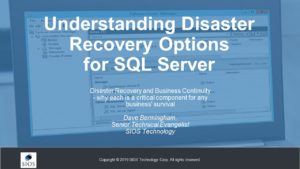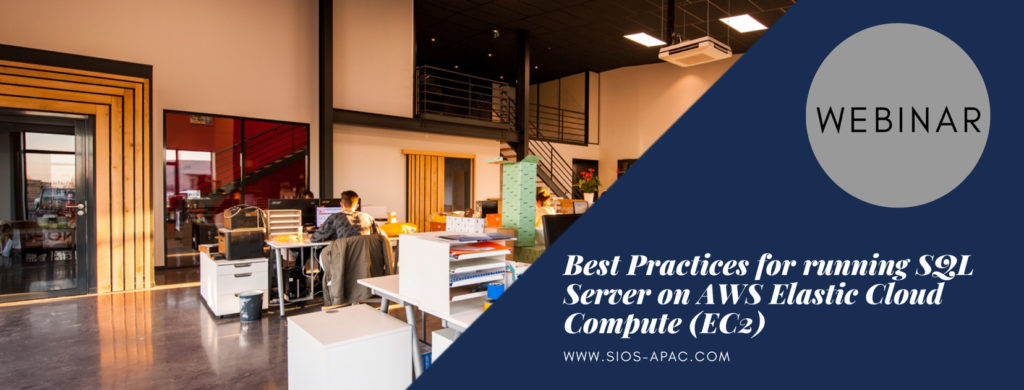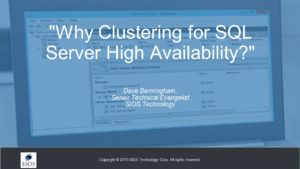| May 25, 2019 |
Webinar: Availability Options and Requirements for SQL Server 2008 in Azure
Webinar: Availability Options and Requirements for SQL Server 2008 in AzureTime is running out for your SQL Server 2008/2008 R2 instances. On July 9th the extended support date for SQL Server 2008/2008 R2 officially runs out. This means no more security updates will be issued. But wait, there is an option. By moving your SQL Server 2008/2008 R2 Instances to Azure, Microsoft will provide an additional three years of Extended Security Updates at no additional charge Running. Before taking the plunge on moving your SQL Server 2008/2008 R2 instances to Azure, you need to understand the availability options and requirements to ensure that your high availability and disaster recovery concerns are addressed. Learn how to deploy SQL Server 2008 /2008 R2 Failover Cluster Instances in Azure properly. This includes addressing the lack of a shared storage option as well as networking requirements including the Internal Load Balancing requirements. Azure Site Recovery will be introduced as a viable alternative as a disaster recovery option which allows for a robust RPO/RTO in an entirely different Azure region. Register Webinar: Availability Options and Requirements for SQL Server 2008 in Azure |
| May 24, 2019 |
Webinar: Understanding Disaster Recovery Options for SQL Server
Webinar: Understanding Disaster Recovery Options for SQL ServerYes – you need a disaster recovery plan! Your SQL Server data depends on it. On this webinar, Dave Bermingham, Microsoft Datacenter and Cloud MVP, explains the difference between Disaster Recovery, Business Continuity and High Availability and why each is a critical component for any business’ survival. Discover what key components should be included in your Disaster Recovery, Business Continuity plans and explore some of the tools available to help achieve your Disaster Recovery, Business Continuity goals. Concerned about end of support for SQL Server 2008? See how SIOS helps customers prepare for SQL Server 2008 EOS. |
Webinar: Best Practices for running SQL Server on AWS Elastic Cloud Compute
Webinar: Best Practices for running SQL Server on AWS Elastic Cloud Compute (EC2)Running SQL Server in the cloud doesn’t have to be complicated or anxiety-inducing. Cloud Service Providers (CSPs) like AWS, have optimized their infrastructure to run SQL Server with price, performance and availability as key requirements. This webinar covers how AWS in partnership with SIOS, addresses those three requirements in their industry leading IaaS offering, EC2. Register Webinar: Best Practices for running SQL Server on AWS Elastic Cloud Compute (EC2) |
|
Webinar: Why Clustering for SQL Server High Availability?
Webinar: Why Clustering for SQL Server High Availability?When it comes to SQL Server high availability (HA), SQL Server Failover Cluster Instance (FCI) has been the standard since 1998 with the release of SQL Server 7. Dave Bermingham, Microsoft Cloud and Datacenter MVP and former Cluster MVP, reviews what clusters are, why you should use them for high availability, discusses SQL Server Failover Cluster Instance concepts and why it is an important part of your Mission Critical SQL Server deployment whether you run on-premises, in the cloud or in a hybrid cloud configuration. Register Webinar: Why Clustering for SQL Server High Availability? |
|
Webinar: Failover Clustering in the Cloud – Understanding Your Options
Webinar: Failover Clustering in the Cloud – Understanding Your OptionsWindows Server 2016 introduced Storage Spaces Direct, to allow for shared storage in Azure that could help with building and configuring a Windows cluster in the cloud. While this sounded like a killer feature (and it can be with proper infrastructure) it runs into challenges in cloud environments with limited bandwidth available for both storage and data traffic. In this webinar, you will learn about the configuration of clusters in the cloud, some real-world examples of problems, and alternatives for maintaining a shared storage infrastructure within Azure. Register Webinar: Failover Clustering in the Cloud – Understanding Your Options |






